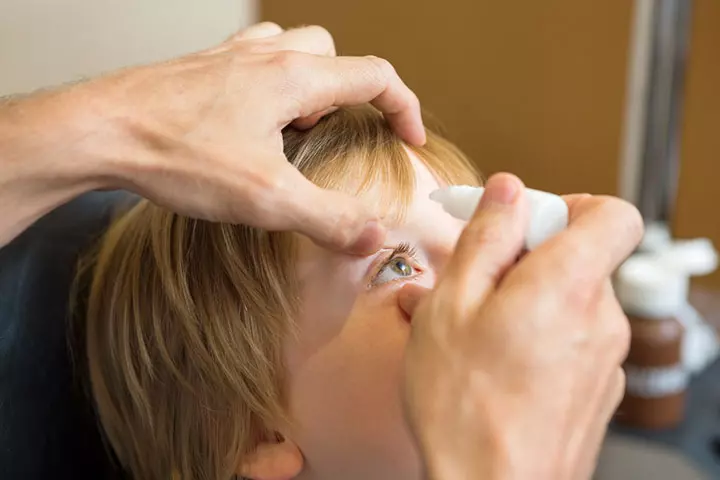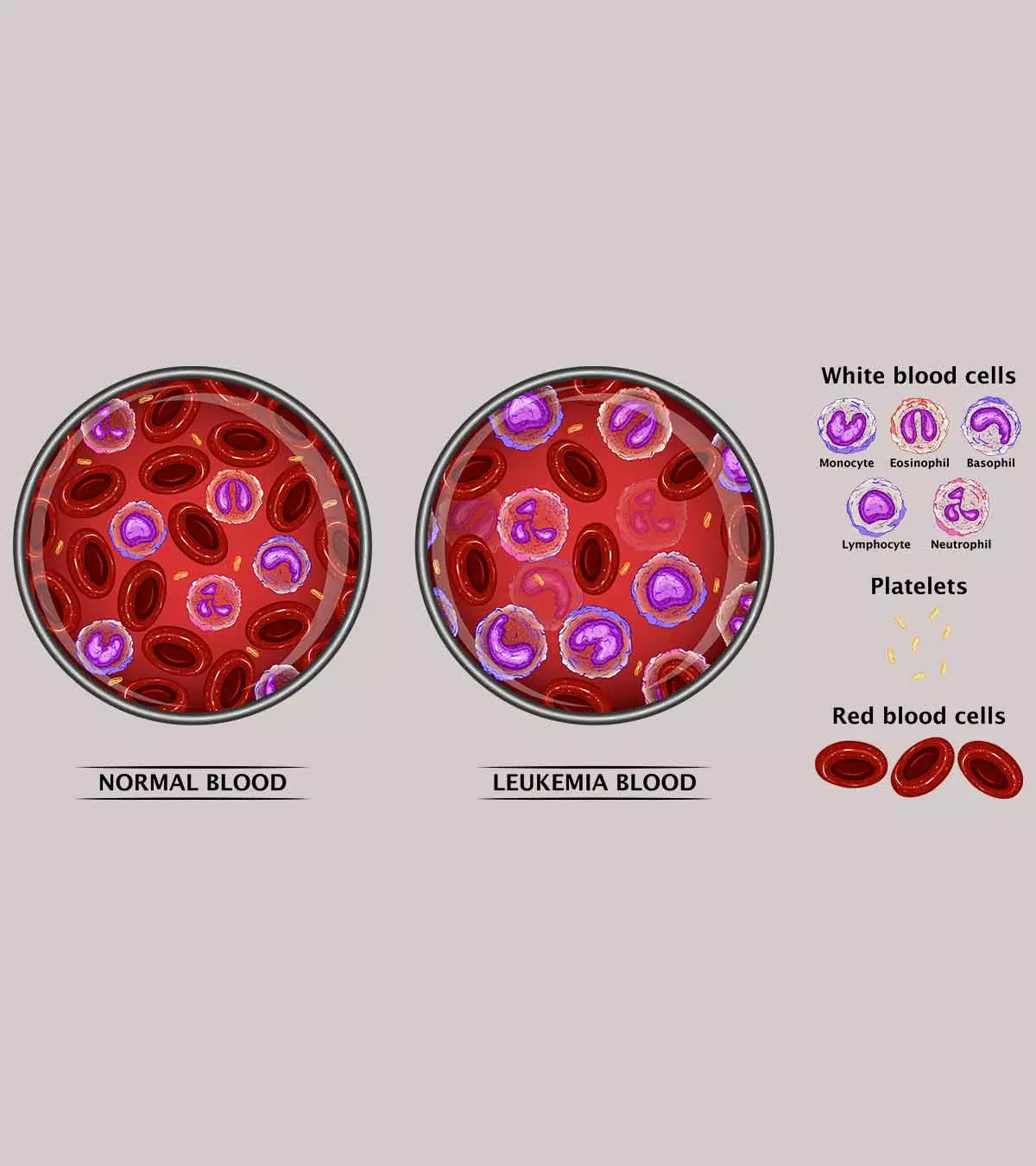
Image: Shutterstock
On average, a baby’s spontaneous eye blinking (SB) rate is fewer than four blinks per minute, which increases with age. The blink rate reaches a minimum of 14 to 17 times per minute by adolescence and rises to 15 to 30 times in adulthood (1). However, if you notice excessive blinking in children, it may indicate an underlying cause.

This post explains some of the common causes of excessive blinking in kids and its complications, treatment, and prevention.
Key Pointers
- Blinking is an involuntary reflex that lubricates the eyes and keeps them clean. A child may blink more when their eyes are exposed to dust, dirt, or light.
- If a child blinks so excessively that it affects their daily activities, it indicates an underlying issue.
- Prompt diagnosis and timely treatment are essential to avert complications.
- Unless caused by a medical condition, excessive blinking in children can be reduced or prevented by following basic eye care like avoiding rubbing the eyes.
Causes Of Excessive Blinking In Children
Blinking is an involuntary and natural reflex that helps lubricate and clean the eyes. Your child may blink more when exposed to light or dust. Sometimes, children may blink excessively as part of a new habit or due to eye strain.
However, if your child blinks so often that it disrupts their everyday activities, you need to know the underlying cause. Also, if your child shows any signs of discomfort or pain while blinking, taking them for an eye exam is a good move. Dr. Ranjodh S Boparai, an ophthalmic surgeon from Philadelphia, Pennsylvania, says, “Excessive blinking is typically a feature of an underlying etiologyiCauses of a disease or a condition , which may be benign or serious. The causes of excessive blinking include eye allergies, dry eyes, corneal foreign body, corneal scratches, ingrown eyelashes, refractive errors (nearsighted or farsighted), strabismus (eye misalignment), amblyopia (lazy eye), environmental changes, stress, anxiety, and habitual tic. Other serious but rare causes of excessive blinking include seizures, Wilson’s disease, multiple sclerosisiAn autoimmune disease that affects the central nervous system, including the brain and spinal cord. , and Tourette syndromeiA disease of the nervous system responsible for causing repetitive, involuntary movements or unwanted vocal sounds .”
Here are some of the most common causes of excessive blinking in children.
- OCD: Compulsive eye blinking is one of the symptoms of obsessive compulsive disorder (OCD). OCD is characterized by obsessive thoughts and compulsions. Your child might blink excessively to soothe themselves during an episode of OCD. OCD eye blinking is generally seen in brief episodes and comes on suddenly (2).
- Tics: Tics in children cause them to make repetitive movements or sounds. Repetitive blinking could often be due to tics (3). Unlike OCD-driven excessive blinking, tics are not caused by the need to relieve an obsessive urge but are involuntary movements of the muscles (4). Tics in children may be caused by sleep deprivation or stress and are benign. According to the US CDC’s National Survey of Children’s Health 2013-2019, Tourette syndrome is relatively common among children in the US, affecting approximately 0.3% of those aged 3 to 17 years. The condition is identified by the presence of multiple motor tics and at least one vocal tic (5).
 Experts say
Experts say
- Eye strain: Children often blink excessively when they suffer from eye strain. According to the Canadian Association of Optometrists, staring at the TV, computer, or phone screen for an extended period or reading books for too long can dry out the surface of the eyes, cause eye strain in children and lead to excessive blinking (6). Hence, restricting children’s screen time is prominent to maintain to safeguard eye health is crucial.
YouTuber Rochelle Abella’s daughter took her for an eye checkup to address her excessive eye blinking issue. Narrating her experience, she says, “The reason for her excessive blinking is probably too much screen time. The doctor advised us to reduce her screen time and take her outside for at least two hours daily because sunlight is also good for her eyes. I am relieved because I have nothing to worry about after the eye checkup (i).”
- Dry eyes: If your child complains of a burning sensation in the eyes or rubs their eyes often and blinks excessively, it could be due to dry eyes. Dry eyes can be caused by a host of factors, including immune deficiencies or neurologic ailments (7).
- Allergies: The same factors that make your child sneeze or have a runny nose may also cause eye allergies and lead to excessive blinking (8). Studies on children aged 4 to 12 years indicated that 61.23% of 578 children had excessive blinking caused by allergic reactions to dust mites (9).
- Blepharitis: It refers to the inflammation of the eyelids. The condition is usually caused by a bacterial infection in the eye (10). Lack of proper hygiene and care of the eyes are common causes of this condition.
- Vision issues: Common vision problems, such as nearsightedness and farsightedness, can also cause the child to blink often and rub their eyes in a futile bid to correct the vision (11).
- Uncorrected refractive errors: When the child already has myopiaiAn eye condition where close objects appear clear while those farther appear blurry (nearsightedness) or hyperopiaiAn eye condition where you can see things that are far away clearly, and nearby objects blurry (farsightedness) , parents may miss out on the need to check and reassess the vision periodically. If there is an uncorrected refractive error, the resulting difference between what is needed and what the child’s glasses offer may cause excessive blinking.
- Cornea issues: These may range from ingrown eyelashes to abrasion on the surface of the cornea. These problems might irritate the eyes and cause excessive blinking in children.
- Strabismus: Strabismus or crossed eyes (squint) may also cause excessive blinking in children. This could be a result of extreme farsightedness or weak eye muscles (12).
There can be single or multiple factors at play for frequent blinking in children. However, its occurrence may decrease with age and vary for girls and boys, as shown in the graph below. The study was done on 578 children, 341 boys and 237 girls, with excessive blinking. The graph indicates that frequent blinking in children is negatively correlated with age. It also shows that the incidence is lower in girls than in boys.

The correlation of frequent blinking in children by age and gender
Source: Causes of excessive blinking in children aged 4-12 years; International Journal of Clinical and Experimental MedicineSigns And Symptoms Associated With Excessive Blinking In Children

Some of the common symptoms associated with excessive blinking in children include (8) (13) (14)
- Rubbing of the eyes often.
- Watering eyes.
- Blurred vision.
- Burning eyes.
- Itching or irritation.
- Difficulty with keeping eye open or concentrating.
- Blinking far more than usual. A young child blinking more than 15 times per minute is a warning sign (9).
- Pink eyes.
- Inflamed eyelids.
- Discharge crusting the eyelashes.
- Mild pain or discomfort
- PhotosensitivityiA condition that causes hypersensitivity to sunlight or other ultraviolet light .
- Difficulty reading.
- Headaches.
- Need to close one eye while seeing something.
- Dramatic vision changes.
- Squinting.
- Stuffy or running nose.
- Coughing or sneezing.
A combination of these symptoms can occur together depending upon the causation of excessive blinking in children.
 Quick fact
Quick factComplications Of Excessive Blinking
The following are some of the complications of excessive blinking in children.
- Excessive blinking caused by underlying factors such as myopiaiAn eye condition that makes it difficult to see objects that are far away , strabismus, or hyperopiaiAn eye condition in which objects that are close appear out of focus could affect your child’s progress at school or their ability to play, learn, and carry out everyday activities.
- Excessive blinking, redness, pain, distress, scratch marks, and watery or discolored eye drainage may warrant medical consultation (8).
- In some rare cases, excessive blinking may indicate neurological ailments, such as BEB (benign essential blepharospasmiA condition that causes involuntary twitches in the eyelid ) and Wilson diseaseiA rare genetic disorder where the body accumulates too much copper, notably in the vital organs such as the liver and brain . BEB may possibly lead to an inability to keep the eyes open (15), while Wilson disease may prevent the body from getting rid of excess copper from the body and affect the entire central nervous system (16).
Diagnosis of Excessive Blinking
The diagnosis may involve a routine eye examination to find out the cause of excessive blinking. Eye infections, eye irritations, and eye strain can be quickly diagnosed via an eye examination (17) (18).
- Expect a physical examination of the eyes and the eyelids.
- The doctor or neurologist may ask the child to identify pictures, read letters, or do some activities to assess your child’s vision.
- The doctor may put in some eye drops to dilate the pupils.
- The doctor may flash a light in your child’s eyes and see how the eye reacts to it.
- To assess eye movement, the doctor might ask the child to follow an object held by the doctor.
- A microscope may be used to magnify and examine the eye.
 Expert says
Expert saysTreatment For Excessive Blinking In Kids

Excessive blinking is usually caused by benign causative factors. The doctor may suggest the following treatments based on the causes.
- Dryness or infection: Eye drops that make up for the lack of tear formation are prescribed for eye dryness. Antibiotic eye drops are prescribed if there is an eye infection. In some cases of persistent infection, steroid eye drops may also be recommended by the ophthalmologist (8).
- Allergic reactions: If the excessive blinking is due to allergies, antihistamines are given (9).
- Vision problems: If the child suffers from vision problems, corrective glasses are prescribed. For refractive error, the doctor may do a thorough eye test and recommend the right eyeglasses to correct the error. The doctor may also recommend vision therapy and exercises to improve overall eye health. In some rare cases, surgery may be advised (11).
- Scratches on the corneal surface: Moisturizing drops or antibiotic drops are given to help the scratch heal. The ophthalmologist may also ask the child to wear an eye patch that prevents them from using the affected eye continuously. If the child has ingrown eyelashes, the ophthalmologist may recommend the use of electrolysis to remove them (19).
- Eye irritation: Apart from using protective gear when in pollution-heavy areas, you can follow preventive strategies outlined by the doctor. These include avoiding bright lit areas and dusty locations, taking breaks during reading sessions, and practicing good eye hygiene (6).
- Tics or habit: If it is due to a tic or compulsive habit, it may be treated via counseling with a child psychologist or behavioral therapy. Often, tics go away on their own (3).
 Quick fact
Quick factFor more serious ailments, the ophthalmologist may recommend further tests before deciding upon a treatment plan. Always consult your doctor for the right prescription before administering any of these treatments.
How To Prevent Excessive Blinking In Children

Follow these simple steps to prevent excessive blinking in your child.
- Avoid irritants: Minimize exposure to irritants, such as dust or pollution. Exposure to bright lights, even direct sunlight, may irritate your child’s sensitive eyes. Ask the child to wear protective glasses or other gear when they step outside.
- Avoid eye strain: Help the children regulate activities that cause eye strain. Demarcate times for reading, writing, screen time etc., and ensure they take breaks in between. No screen time for babies less than two years of age. Also, ensure that the lighting inside the house is right for the eyes and not too bright or too dull.
- Reduce stress and anxiety: Avoid putting pressure on the child in situations that stress them out. If the child has trouble handling anxiety or seems to get anxious in certain situations, talk to a child psychologist for ways to help them deal with it.
- Schedule outdoor playtime: Good overall health leads to good eye health too. Outdoor play ensures that children stay healthy and active, and it also keeps stress under control. Schedule outdoor play every day so that the child can do activities that do not strain the eyes.
- Eliminate the risk of dry eyes: Proper diet helps avert dry eye problems. Add plenty of greens and omega-3 foods to their meals (20).
- Prioritize eye care: Encourage your children to practice good hygiene, such as regular handwashing and avoiding touching their face and eyes with dirty hands. Wash the child’s eyes with clean, cold water frequently and clean the eyes as advised by the ophthalmologist. Avoid excessive scrubbing or rubbing.
- Ensure proper sleep: A good night’s sleep helps the child’s eyes get proper rest. Make sure your child does not stay up too late and that they get at least eight hours of sleep per night.
- Take the prescribed medication diligently: If the doctor has prescribed drops for continuous use, make sure you follow the instructions diligently. For example, if the excessive blinking is due to eye dryness, and the doctor has prescribed drops to keep the eyes moist, consistent use can prevent the recurrence of excessive blinking.
Frequently Asked Questions
1. Do children with autism blink a lot?
Studies have shown that children with autism may have an increased frequency of eye-blinking behaviors. They may also display a typical eye-blink conditioning compared to the control group (21) (22). Dr. Boparai adds, “When typical children are shown emotional scenes in movies, they tend to blink less. In contrast, children with ASD blink normally during emotional scenes. This hints that children with ASD struggle with recognizing emotional situations. Also, typical children will focus on the eyes when someone is talking to them, while children with ASD tend to focus on other features of the face.”
2. What does excessive blinking mean in psychology?
A few studies have reported that excessive blinking could indicate increased cognitive thinking and cerebral dopamine activity levels. Also, spontaneous eye blink rate could be associated with abnormal psychotic symptoms (23) (24). However, more studies are needed to establish these hypotheses.
3. Is excessive blinking a common issue in children or relatively rare?
The severity of excessive blinking largely depends on its underlying cause. In rare cases, excessive blinking is a symptom of a serious problem. It is often linked to corneal problems, habitual tics, uncorrected refractive errors, and misaligned eyesight (17).
Excessive blinking in children usually resolves independently or can be quickly addressed with the help of your child’s ophthalmologist. You may also prevent its recurrence in children by avoiding irritants and eye strain, minimizing their stress and worry, ensuring they get enough sleep, etc. Also, ensure your child receives an eye exam at least once in a year or two to aid in the early diagnosis of any underlying problems (25). Finally, remember that proper eye care is important, and excessive blinking may affect your child’s everyday activities even if it does not indicate a serious condition.
Infographic: Causes And Preventive Measures For Excessive Blinking
It is important to take your child to a pediatrician or an ophthalmologist if you find them blinking excessively. Take a glimpse at the below infographic for the causes and tips to prevent excessive blinking in your child.
Some thing wrong with infographic shortcode. please verify shortcode syntax
Does your child blink excessively? Watch this informative video to learn about the causes of this phenomenon and the steps you can take to help your child.
Personal Experience: Source
MomJunction articles include first-hand experiences to provide you with better insights through real-life narratives. Here are the sources of personal accounts referenced in this article.
i. Freya’s eye check-up– excessive blinking??!!! || Rochelle Abella vlogs;https://www.youtube.com/watch?v=ACVIMlQoza0&feature=youtu.be
References
1. Leigh F. Bacher; Factors Regulating Eye Blink Rate in Young Infants; HHS Author Manuscripts (2011).
2. Obsessive-Compulsive Disorder; National Institute of Mental Health
3. Tourette Syndrome; The Nemours Foundation
4. OCD and Tourette Syndrome: Re-examining the Relationship; International OCD Foundation
5. Rebecca H Bitsko et al.; Mental Health Surveillance Among Children – United States, 2013-2019; Pubmed (2025)
6. Children and Screen Time; Canadian Association of Optometrists
7. Are We Missing Dry Eye in Children?; American Academy of Ophthalmology
8. Why Is My Toddler Blinking a Lot?; Cleveland Clinic
9. Ru-Lian Zhao et al.; Causes of excessive blinking in children aged 4-12 years; International Journal of Clinical and Experimental Medicine (2019)
10. What Is Blepharitis?; American Academy of Ophthalmology
11. Nearsightedness (Myopia); The Nemours Foundation
12. Strabismus (crossed eyes; American Optometric Association
13. Eye Strain; Cleveland Clinic
14. Blinking; Cleveland Clinic
15. Benign Essential Blepharospasm; National Organization for Rare Disorders
16. Wilson Disease; Johns Hopkins Medicine
17. Excessive Blinking in Children; The American Academy of Ophthalmology
18. Excessive Blinking in Children; American Association for Pediatric Ophthalmology & Strabismus
19. Corneal Abrasion and Erosion; American Academy of Ophthalmology
20. Top foods to help protect your vision; Harvard University
21. Ozdem Erturk et al., Startle and blink reflex in high functioning autism; Clinical Neurophysiology (2016).
22. L L Sears et al., Abnormal classical eye-blink conditioning in autism; Journal of Autism and Developmental Disorders (1994)
23. C Mohr et al., Blinking and schizotypal thinking; Journal of Psychopharmacology (2005)
24. Rafal Paprocki and Artem Lenskiy; What Does Eye-Blink Rate Variability Dynamics Tell Us About Cognitive Performance??; Frontiers in Human Neuroscience (2017)
25. Eye Exam: What to Expect; Cleveland Clinic
Community Experiences
Join the conversation and become a part of our nurturing community! Share your stories, experiences, and insights to connect with fellow parents.
Read full bio of Dr. Rana Chanchal
- Dr. Ranjodh S Boparai is an ophthalmic surgeon with 5 years of experience. He is a graduate in Medicine and Neuroscience from Weill Medical College of Cornell University, Dr. Boparai has over 50 publications, 20+ awards, and 10+ research fellowships to his name. He currently serves at the US Department of Veterans Affairs and is the co-founder of eyecare company CorneaCare.
 Dr. Ranjodh S Boparai is an ophthalmic surgeon with 5 years of experience. He is a graduate in Medicine and Neuroscience from Weill Medical College of Cornell University, Dr. Boparai has over 50 publications, 20+ awards, and 10+ research fellowships to his name. He currently serves at the US Department of Veterans Affairs and is the co-founder of eyecare company CorneaCare.
Dr. Ranjodh S Boparai is an ophthalmic surgeon with 5 years of experience. He is a graduate in Medicine and Neuroscience from Weill Medical College of Cornell University, Dr. Boparai has over 50 publications, 20+ awards, and 10+ research fellowships to his name. He currently serves at the US Department of Veterans Affairs and is the co-founder of eyecare company CorneaCare. 
Dr. Po-Chang Hsu is a medical doctor and medical content expert. He received his medical degree from Tufts University School of Medicine in Boston in 2016. Previously, he did a master’s degree at Harvard University and wrote a thesis on neuroimaging in schizophrenia patients at Brigham and Women’s Hospital. He currently works at Alpas Wellness.
Dr. Po-Chang Hsu is a medical doctor and medical content expert. He received his medical degree from Tufts University School of Medicine in Boston in 2016. Previously, he did a master’s degree at Harvard University and wrote a thesis on neuroimaging in schizophrenia patients at Brigham and Women’s Hospital. He currently works at Alpas Wellness.
Read full bio of Dr. Ritika Shah
Read full bio of Rebecca Malachi
Read full bio of Vidya Tadapatri

















